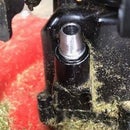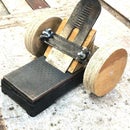Introduction: Bible Marking Pens
These represent a sampling of most of the pens I have used for making notations on the thin paper used to print Bibles. They are a fountain pen with red ink and an extra fine point, a dry mark pencil, a 0.2mm crafter's pen, and a red ballpoint.
Step 1: The Problem
This is a page from a Bible I use often. The paper is so thin that a faint image of the factory print from the other side of the page is almost legible. Although I did not make any notations on this page, I did highlight some cross reference listings with a yellow dry marker pencil. A dry marker pencil is good for highlighting, but useless for making one's own notations. Dry marker pencils come in quite a variety of colors. They need frequent sharpening, but there is no danger they will go through the paper.
Step 2: Bleed Through
I have been using this copy of the Greek New Testament over the last 45 years. It contains markings from a wide variety of pens. This page shows markings from two pens that bled through the paper. Look to the right of the numeral 8. You can see "NB" (Nota Bene = pay close attention, Important!) in reverse from the other side of the paper. It was made with a fine point fountain pen, but that pen put too much ink onto the paper for marking Bible paper, and it bled through. Notice the red "5-6" below the "NB." For a while I used cheap red ballpoint pens for Bible marking. Within a few years the ink took on an oily look and bled through the paper, even though it looked fine for a while. I quit buying those cheap red pens. The red ballpoint in the Introduction is a pretty good pen, much better than the cheap ones I used years ago.
Step 3: Black Pens
The text underlinings on this page were done with a better quality black ball point. After many years, the ink still has not bled through to the other side. The same is true of the "cf v. 5" (= "see verse 5") notation, which was also made with the same ballpoint. The "Mt 12:28" notation was done with the 0.2mm crafter's pen. The crafter's pens work very well and can be purchased in various line widths. The problem is that they run out of ink quickly and are not refillable. While I like them, I gave up on them because of their short life. I believe the "IDB 2" notation was also done with a crafter's pen. ("IDB" refers to a multi-volume Bible dictionary set I use.) It appears I went back later to add more detail and used a very fine point Kohinoor pen for the "p 631" notation and for the additional notations beyond it that are illegible here. The Kohinoor pen is a quality instrument available at fine art stores. They are expensive to buy and require a lot of cleaning and maintenance to keep them working well. You can see the Kohinoor pen here.
Step 4: PaperMate Pourous Point Pens
For a time I used red PaperMate Flair pens. I believe they were Porous Point pens, although they may have been felt tipped. It was the mid-1970s then. They worked pretty well. Although the red underlinings on this page are clear and easy to read, they did not bleed through to the other side of the page. Different point widths are available, but they are generally a little thick for notations in narrow spaces.
Step 5: What I Use Now
Currently I am using the extra fine point fountain pen shown in the Introduction photo. It is a kit built pen from about 15 years ago. At that time, several points were available and I bought an extra fine point. I loaded the pen with red ink. The pen is convenient and easy to refill. The photo shows a notation I made with it. It does, however, bleed through some on the thinnest papers. See the second photo. But, I try to write quickly so the pen does not sit long in any one place. It also helps if the ink is not overly watery. And, I can always check the other side of a page before writing to be sure I will not obscure anything I want to remain free of bleed through. So long as the color of ink I use for notations is different from that of the text, bleed through is less of a problem, too.
It would be nice if I could recommend one pen for everyone. Much depends on whether you merely want to highlight, or to add your own notations, too. I use several Bibles and mark them all. Usually I do some underlining and may write a reference to an occasional cross reference. Some Bible papers bleed through more easily than others. You will probably need to do a little experimentation. But, by all means avoid cheap ball points and pens that put quite a bit of wet ink onto the paper. Those may be fine for writing on normal stationery, but not for marking the thin papers used in printing Bibles. All in all, I prefer my extra fine point fountain pen, but those are not always easy to find. In addition, one pen maker's extra fine fountain pen point may be another's fine. There is little uniformity between brands on such things.













